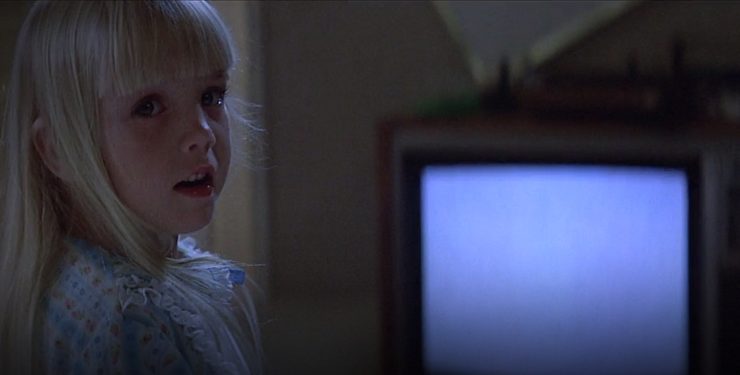Earlier this month marked the 40th anniversary of one of my all-time favorite movies: Poltergeist. When I was a smaller Leah, I would sometimes hang out at a neighbor’s house—these neighbors had a collection of videotapes, among them E.T. and Poltergeist. The first time I went over they invited me to choose a movie to watch, presumably thinking I’d go for family-friendly E.T.
But nay.
For some reason I latched onto Poltergeist like malnourished lamprey. I had to watch it every time I was over there. The adults would be off doing whatever boring stuff adults do, and I’d be about three inches away from the TV screen, reliving the horrific events at Cuesta Verde, until my mom made me leave. Given that, you’d think I’d remember it, right? But mostly what stuck was, if you’ll forgive my childhood mental capitalization: The TV People, the Scene with The Chairs, The Tree, That Fucking Clown, “Don’t go into the Light!” and Carol Anne and Her Mom Covered in Goo.
Imagine my shock when I revisited the film and discovered that not only had I misremembered a ton of stuff, but also that this is one of the weirdest movies I’ve ever seen. The reality it presents is absolutely alien. Some of that is simply that suburban American life in 1982 was a different world than the one we live in now, but also this movie is just… weird.
Let’s begin by noting the obvious thing: Steven Spielberg had an idea for a modern haunted house movie. Because of his E.T. contract, he couldn’t direct it himself. So who does he hire to make this movie about a nice suburban family beset by ghosts? The guy who made the fucking Texas Chainsaw Massacre.
Texas Chainsaw Massacre is an incredible film. A great horror movie, a great commentary on capitalism and outsider art and cults and the U.S. in the 1970s. (If you want to watch a good conversation about it, allow me to direct you to this discussion between film critic Walter Chau and John Darnielle.) But “The director of this fucking nightmare should absolutely make a suburban ghost story about the power of family next” is not a thought that would occur to a lot of people after watching it, and the fact that it did occur to Spielberg fills me with admiration.
The opening of the film shows us a lost world where everyone can take whole weekends off, houses are not only huge, and single family, but also a mess, and no one gives a shit because they’re too busy relaxing on their days off. Kids roam the neighborhood, creating their own societies and playing dangerous pranks on adults with no visible repercussions. And, most shocking of all: TV stops at night. Like they run out of TV. Every night. The station plays the national anthem, and TV… stops.
To my 2022-burned eyes, this would be a vision of utopia if it wasn’t so white and heteronormative.
But now a rundown of all the stuff that leapt out at me when I re-watched the film:
Casual Misogyny!
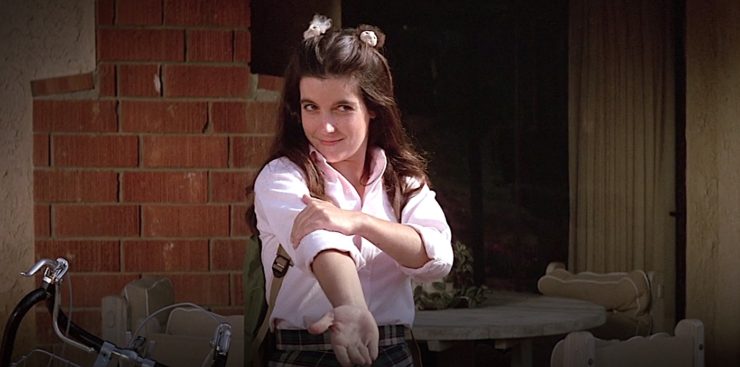
A pool is being dug! Next to a waterbed (and cocaine, I guess), this is the height of ’80s decadence! It also leads into one of the most jarring scenes in the film. The construction crew who are digging the pool, who work for Steven Freeling, openly ogle and hoot at Steven’s 16-year-old daughter, Dana. They do this in the Freeling’s backyard, as Dana leaves for high school, in full view of Dana’s mother, Diane. This is squicky, but par for the course in an ’80s movie. What surprised me was the response: Dana replies to the men with a theatrical take on the “up yours” hand gesture, and her mother smiles and nods in approval from the kitchen window.
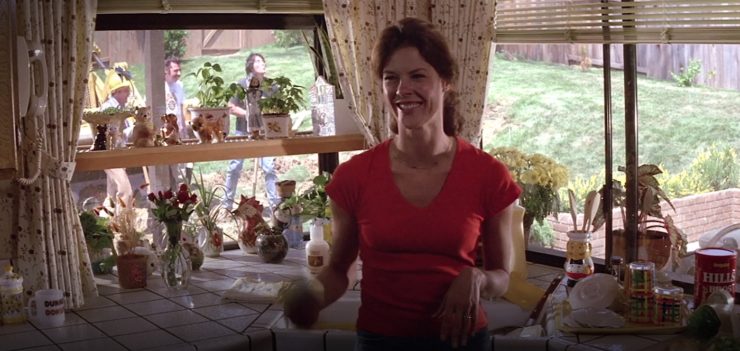
At no point does she yell at the men for sexually harassing her underage daughter. At no point does their boss, Dana’s dad, threaten any kind of consequences. I’m actually not sure what I think of this? In a way it’s amazing to see the kid handling it on her own, and to see that her mom is proud of her for doing so. But also, maybe speak to the guys you’re paying about not harassing your daughter? Or like, anyone?
Foreshadowing, With Added Gender Norms!
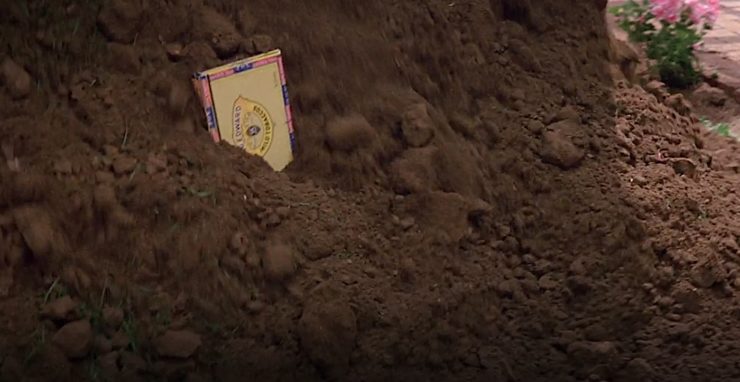
When Carol Anne’s canary dies, the women of the family bury it. Diane forces Dana to stand with her while Carol Anne prays for Tweety. Her son Robbie, meanwhile, is not only allowed to skip the funeral, but Diane doesn’t seem to care when he yells down from the creepy tree asking if they can dig Tweety up once he’s a skeleton, and Steven never participates in the funeral at all. Then E Buzz, the family’s excellent Golden Retriever, does start digging him up, and a scene later we see the construction guys unearth the poor bird with a backhoe while they’re digging the pool. This serves as a darkly hilarious sign of things to come once all the corpses start popping up.
Weed!
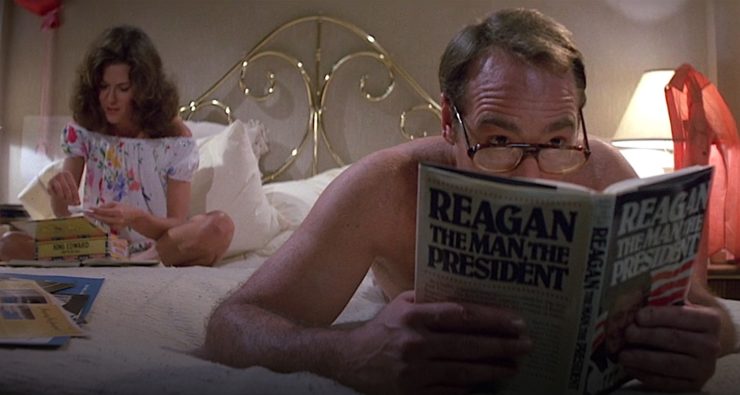
When this film came out, in 1982, marijuana was fully and completely illegal in the U.S. (which is fucking absurd and reparations should be made to every single person incarcerated for selling it) and usually, if you saw anyone smoking in a movie it was a burnout teen in a comedy, a teen about to be slashed in a slasher movie, or a cartoonish hippie. But here we have a pair of responsible adults, homeowners, who have been parents for 16 years. Steven is one of the most respected people at his company, and he’s a man who is choosing to read a book about Ronald Reagan, for fun. After they say goodnight to the kids, they shut themselves up in their bedroom and break out the weed, giggling and jumping around on the bed.
In a movie that focuses on childhood fears, and tips into a lot of special effects by the end, we get a warm, human, adult scene. We get to see Steven and Diane’s bond through their silliness, how relaxed they are together, how they have a closed, intimate circle apart from the circle they share with their children. But there’s nothing fraught here. It might have turned sexual if Robbie hadn’t come in, but this isn’t an automatic “the parents are finally alone” type scene. There’s no a discussion of finances, or the mortgage, or one of the kids having trouble at school, or the car needing an oil change. They’re just being, together. The only thing in the scene that turns out to be “important” is Diane’s worry that Carol Anne might fall into the unfinished pool—and even that turns out to be a red herring, as it’s Diane herself who almost drowns.
Technology!
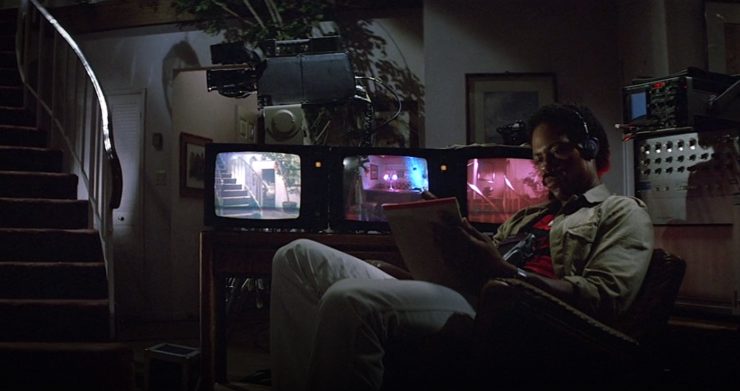
To return to my faulty memory—the most iconic line from Poltergeist is “They’re heeere”—five-year-old Carol Anne’s announcement that “the TV people” have crossed into our world. For the first half hour of the film, we’re repeatedly shown Carol Anne staring into a static-filled screen like William Gibson contemplating a skyscape. But once “the TV people” have come into the house, the television is barely referenced again. After Carol Anne has been taken, it helps the family hear her voice from The Other Side, but the spirits themselves seem more interested in messing with the lights in the kitchen, and the actual portals to and from The Other Side are in the kids’ closet, the wall above the Freeling’s bed, and the ceiling over the living room, respectively.
I think it’s also interesting that while the family is able to find some parapsychologists to help them (more on them in a bit) the team doesn’t really have a plan to fight the ghosts, or get Carol Anne back. This is clearly the worst haunting they’ve ever dealt with, and their big play is to… record it. Their office really looks like an AV Club, with cameras and projectors cluttering the background and bookcases filled with videocassettes and I’m assuming Betamax? When they come to the house, Ryan enthusiastically tells the family about capturing spirit activity via a time-lapse camera, and he and Marty set up video cameras and audio equipment. They’re able to record the spirits, which is cool! But the tech doesn’t seem to help much beyond making Carol Anne’s voice clearer, and in the end plain old-fashioned rope is the most useful ghostbusting equipment.
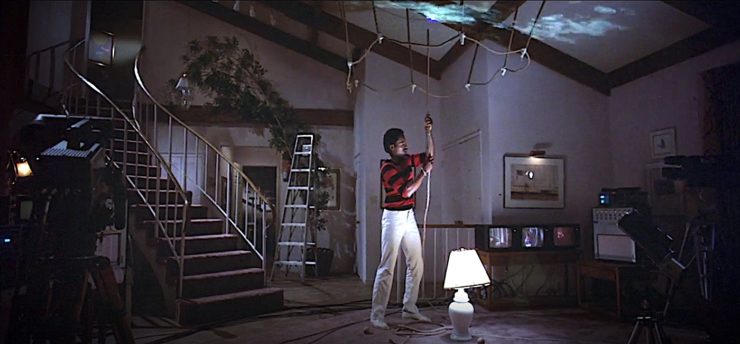
In the closing scene, after the family has checked into a hotel room, Steven wheels the TV out onto the landing, and it’s a hilarious punchline to the film. But it also hit me on rewatching—this is just his attempt to exert any kind of control over the situation they’ve all lived through. The spirits weren’t simply confined to one mode of attack, and he’d have to throw all the lights, electrical wiring, food, and toys out if he really wanted to be safe. And also to request a room with no closets, walls, or ceiling.
Boomers, Two Ways
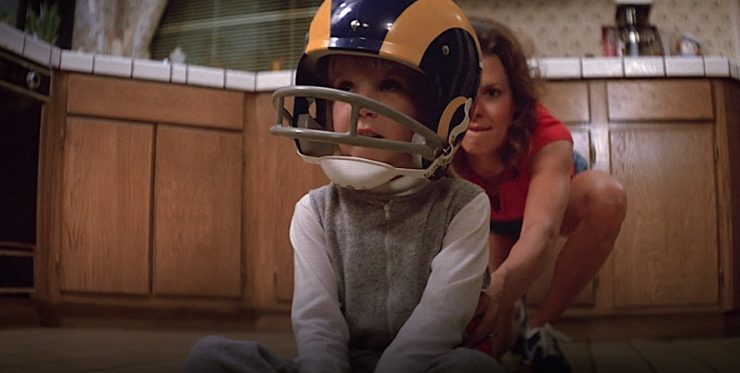
When the poltergeist activity first begins, Diane is positively giddy about it. She accepts the existence of “the TV people” immediately, and seemingly as soon as she figures out that some mysterious uncanny force can slide objects across the kitchen floor, she decides to test this by slapping a football helmet on her five-year-old daughter and offering her up to said mysterious uncanny force for a demo. When Steven gets home, Carol Anne is complaining because Diane never made dinner, as she was too busy with her impromptu paranormal investigation. As the spirits oblige by sliding Carol Anne around like a Swiffer, the kid muses aloud on which type of pizza she wants to get. Steven reacts to his entire reality being upended with horror—and by banning everyone from the kitchen. (Again, the Reagan fan needs his illusion of control.) Diane, the one who was reading Carl Jung in bed, is ecstatic to have proof of the paranormal. Even after Carol Anne is taken, she finds the spirits beautiful and deserving of empathy. Much like the weed scene, this could have just been a special effects-driven “haunted house” moment, but instead serves as an illustration of the characters—this time highlighting Steven and Diane’s opposing responses to the uncanny.
We Bust Ghosts Differently on the West Coast
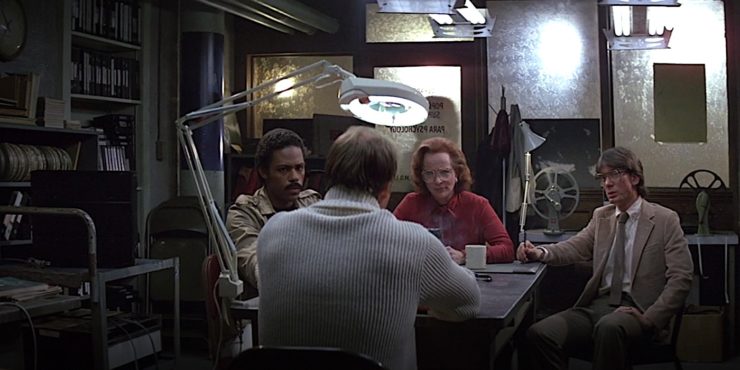
After Carol Anne is taken, Steven goes to find help at the local university, as one does. The people he finds (who prove to be remarkably helpful) work out of an office that’s apparently part of the “Department of Popular Beliefs, Superstitions, and Parapsychology”—the most California academic department I’ve ever heard of. The parapsychologists are Dr. Lesh, a kindly older woman whose doctorate is in psychology, who’s made ghost-hunting a hobby, and who swigs an unnamed liquor straight from a flask, and her two younger assistants, Martin and Ryan, who unfortunately get zero backstory.
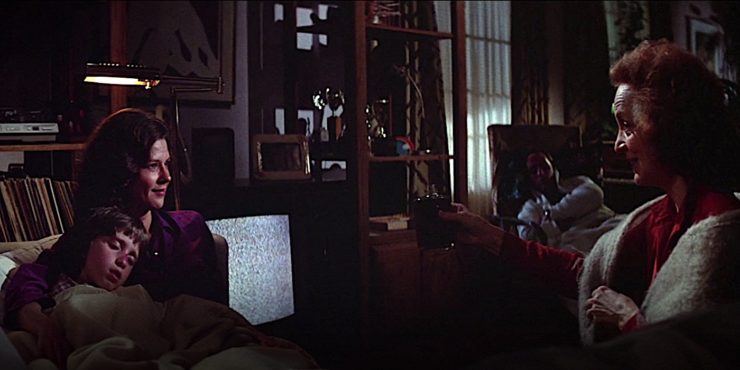
While Marty leaves the project early after a couple of terrifying meat-based hallucinations, Dr. Lesh and Ryan stick it out, with Dr. Lesh offering stellar emotional support, and Ryan figuring out how the portals work. They also bring in the eccentric Tangina, the one who works out a rescue plan—and the only one who actually tries to help the spirits as well. It’s fantastic watching highly theoretical occultists come up with a DIY solution to a haunting. I want to know what brought these people together, and I want them to get a crossover movie with the Ghostbusters.
Um.
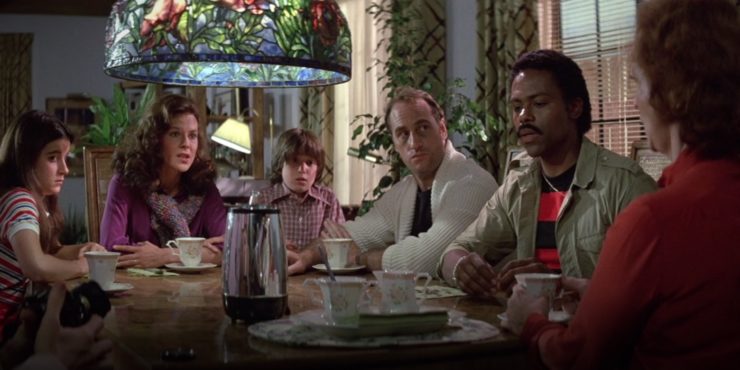
Steven gives the team a rundown of the paranormal activity at his house, but the thing that really got me was his bullet list of ages:
- Diane turned 32 so recently that Steven says “31” before correcting himself;
- Dana’s 16;
- Robbie’s 8;
- Carol-Ann is 5.
So, um, can we talk about how Diane had Dana when she was...15? 16? At least there isn’t a Marion Ravenwood-esque age difference here, but she and Steven had their first kid together when she was, what, a junior in high school? As a child watching this, “32” sounded impossibly old to me, but rewatching it I had to grapple with the fact that these two had their first kid the year Rubber Soul came out, and maybe didn’t even finish high school?
Robbie!
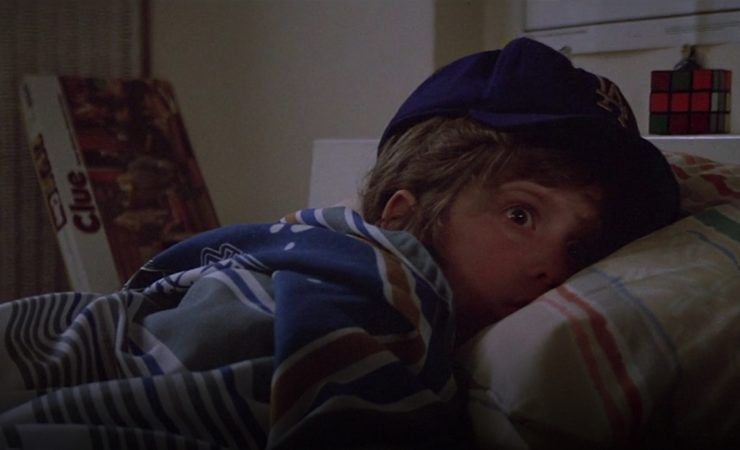
Robbie Freeling lives within a cage of terror. When we meet him he’s forcing himself to climb a tree, which he hates.
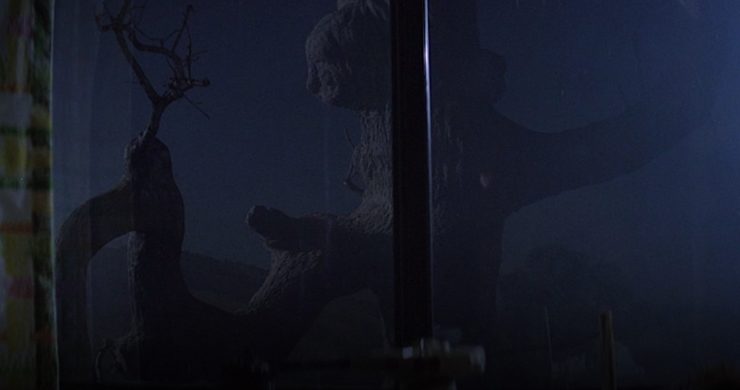
A few scenes later he can’t sleep beneath the watchful eyes of a clown doll, which he hates.
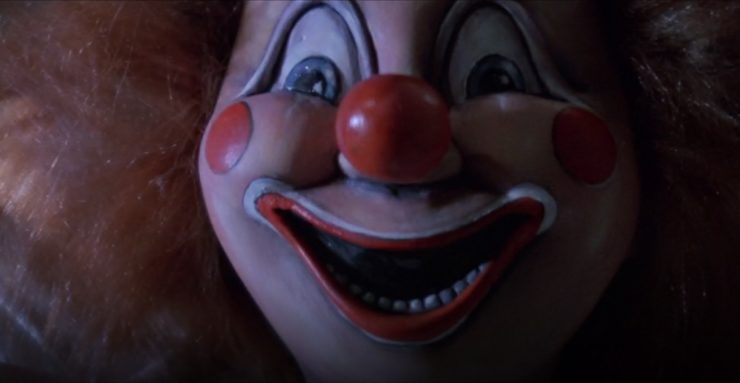
Which, fair enough.
(He solves this problem not by moving the clown doll, but by throwing a Chewbacca jacket over it, so he can sleep beneath the watchful eyes of a Wookiee. Good call.) When a thunderstorm rolls over the town he’s not only cowering fear from the thunder, but also convinced the tree, which to be clear does not have eyes, is looking at him.
This is all before the haunting starts. This kid showed up haunted.
Later, of course, he has to live through all of his worst fears. The tree tries to eat him during a thunderstorm that spawns a tornado. He’s the first one to realize that Carol Anne has been taken, and it takes long minutes before his family hears his shrieks of horror once he figures it out. The clown doll, possessed by poltergeists, drags him under the bed and strangles him. The haunted closet almost gets him. When the parapsychologists come, Dr. Lesh talks to him about the afterlife, and his immediate thought is that the bullies that used to beat him up for lunch money have since “got hit by a truck” and might be “upstairs right now!”
As I said, a cage of terror.
But by far the worst thing that happens to Robbie is done by his parents, in the scene that was probably the most shocking to me on rewatch.
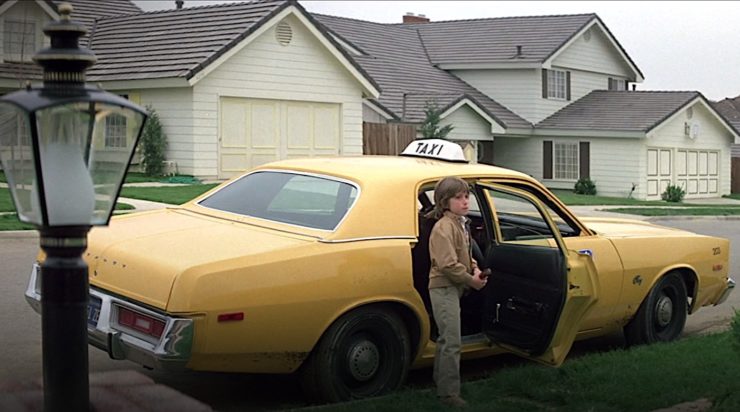
Steven and Diane decide to send Robbie away for his own safety. Which, yes, probably they should get their other vulnerable child out of the house. But. Why are they putting that traumatized kid in a cab to go to grandma’s by himself??? Can’t a friend take him? Or like, they could call grandma to pick him up?
But no!
And they don’t even put him in the cab! Steven and Diane stand in the doorway and watch while he loads his own suitcase into the backseat.
Look at E Buzz! Even he knows this is bullshit!
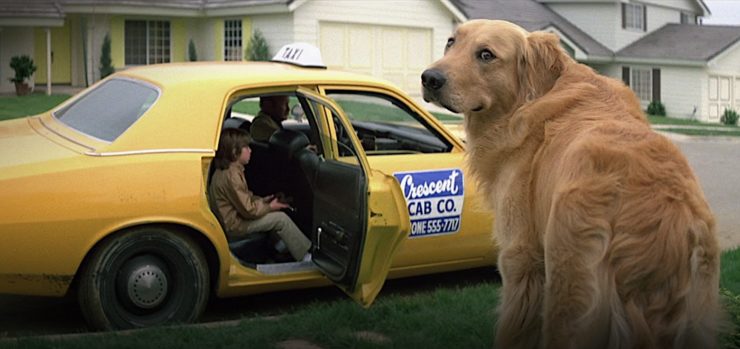
And THEN. His mom yells down to him: “Robbie? Call me, OK?”
W H A T.
Like, won’t grandma call when the traumatized eight-year-old whose sister was kidnapped by literal ghosts arrives at her home??? To let his terrified parents know he’s there, and safe? To check in on said parents, one of whom is her own child? What, is she gonna give Robbie a dime and send him out to a payphone on the corner?
What the hell is with these people?
Vaginas!
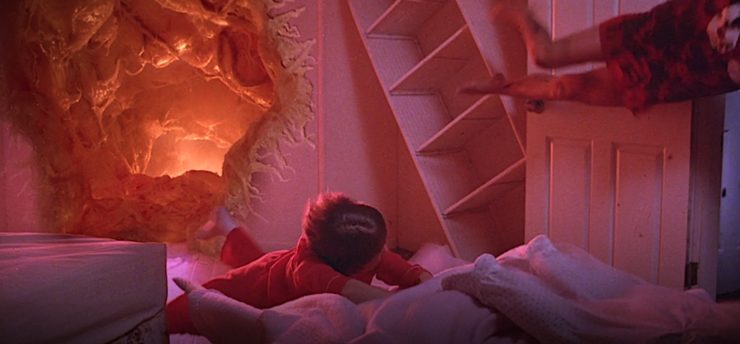
I was trying to think of a good way to put this, but I guess I’ll just say it: Poltergeist is full of vagina-imagery.
Off the top of my head:
- Robbie is pulled into a tree vagina in a scene that riffs on the sexualized Evil Dead tree attack;
- Carol-Anne is pulled into the closet vagina;
- Her mother’s rescue is explicitly framed as a rebirth: Diane goes into the closet vagina, is pulled through The Other Side via a rope/umbilical cord, and she and Carol Anne end their ordeal in a bathtub, covered in pink ectoplasm/afterbirth;
- The pool becomes a sort of corpse-filled “anti-womb” when Diane nearly drowns there during the climactic rainstorm/battle with evil.
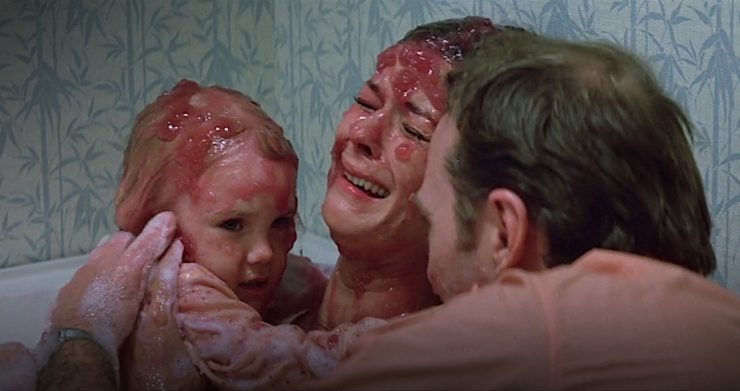
This is all in a story that opens with a scene of the teen daughter, who has just reached the age her own mom was when she had her, being sexually harassed by the men digging the pool—creating the anti-womb—and which ends with the family seeking shelter in the hotel where the daughter has recently become sexually active.
And in case you think I’m being ridiculous with all these vaginas, LOOK AT THIS CLOSET.
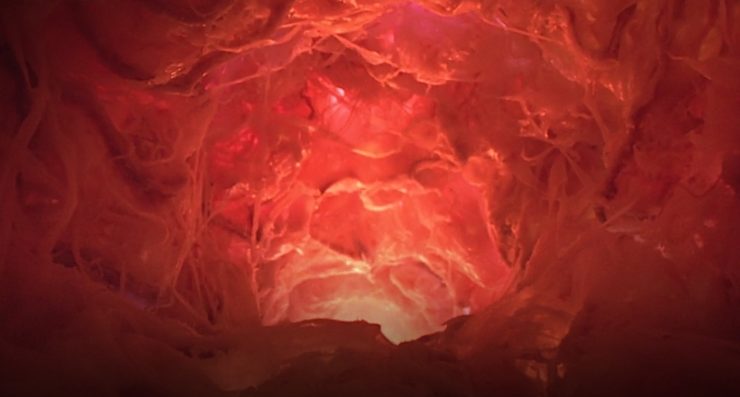
I don’t have anything specific to say about any of this, but I think it’s fascinating that the more you look at this “suburban haunted house movie” the more it seems to become (like The Exorcist and Rosemary’s Baby) a story about the terror of the female body, and possibly the idea that female sexuality can destroy the modern American family. Also? It’s a fun note that pubescent girls’ uncontrolled telekinesis used to be a popular explanation for poltergeist activity.
Cosmology!
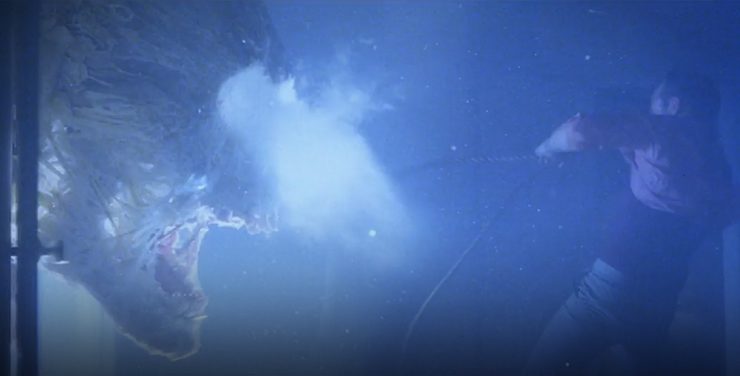
I grew up thinking of Poltergeist as a ghost story, or, really, a haunted house story. But it isn’t, exactly. Even the name “poltergeist” doesn’t quite fit, as poltergeists are thought to be spirits that attach to a person or family and torment them with stuff like throwing cutlery around or switching lights on and off—which these spirits do, but they also drag a child bodily into a liminal zone between life and death.
When we meet Dr. Lesh, she explains to Robbie that sometimes people don’t make it to the “wonderful light” that appears to the dead.
Maybe they didn’t want to die. Maybe they weren’t ready. Maybe they hadn’t lived fully yet or they’d lived a long, long time and they still wanted more life. They resist going into that light, however hard the light wants them. They just… hang around. Watch TV, watch their friends grow up, feeling unhappy and jealous—and those feelings are bad. They hurt. And then, some people just get lost on the way to the light, and they need someone to guide them to it.
When Tangina shows up in all of her Capote-esque glory, she builds on Dr. Lesh’s foundation.
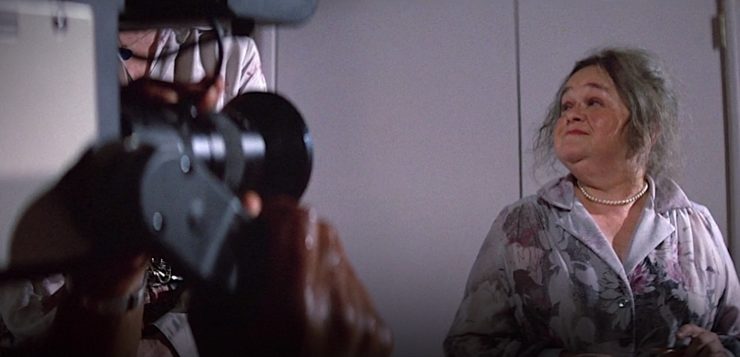
She explains that part of the problem is that Carole Anne’s “life force” is so powerful it’s distracting the dead from the light, and that
These souls, who for whatever reason are not at rest, are also not aware that they have passed on. They’re not part of consciousness as we know it. They linger in a perpetual dream state, a nightmare from which they cannot awake. Inside the spectral light is salvation, a window to the next plane. They must pass through this membrane where friends are waiting to guide them to new destinies.
But also the reason that Carol Anne is over there in the first place is a “terrible presence” who is lying to Carol Anne and using her as a pawn to distract the dead. Tangina concludes her TedTalk by telling the terrified parents: “To her, it simply is another child. To us, it is the Beast.”
So. Uh.
In one monologue we go from “ghosts are haunting this suburban home” to “dead souls are being used as weapons against the living by the Devil”—The Beast is the Devil, right? Which would kind of knock the movie into a different horror subgenre, more in line with something, again, like The Exorcist, where a thoroughly modern family is targeted by an evil force who uses an innocent young girl as a conduit—and said family, being thoroughly modern, is utterly unequipped to deal with it.
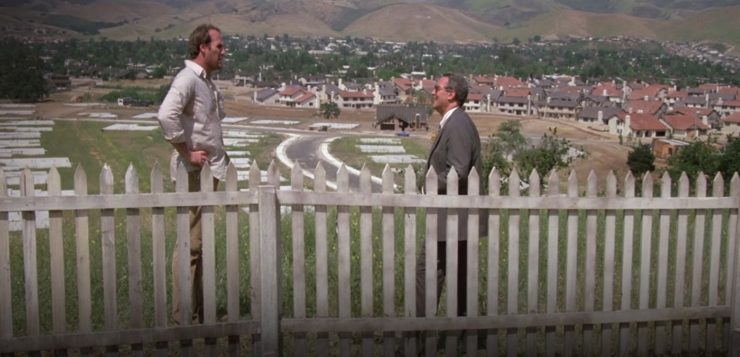
This reading is supported by a scene between Steven and his boss. The boss offers Steven a new, better house than their current, five-year-old one, and during the conversation Steven learns that Cuesta Verde was built on top of an old cemetery. When he asks, “Isn’t that sacrilegious or something?” his boss scoffs: “It’s not ancient tribal burial grounds! It’s just… people. Besides, we’ve done it before.” The only downside is that people have to drive five minutes farther to visit their loved ones at a new cemetery. (Obviously, the boss is lying, they only moved the headstones.) But what I find fun is that it is impossible for me to see this scene as anything other than a deal with the Devil. The boss brings Steven up to a hill, overlooks his kingdom, and offers Steven a place up there too—explicitly saying that ruining the older houses’ views will not be Steven’s problem once the Freelings are up on the hill looking down on everyone.
Shit like this makes me glad I went to grad school.
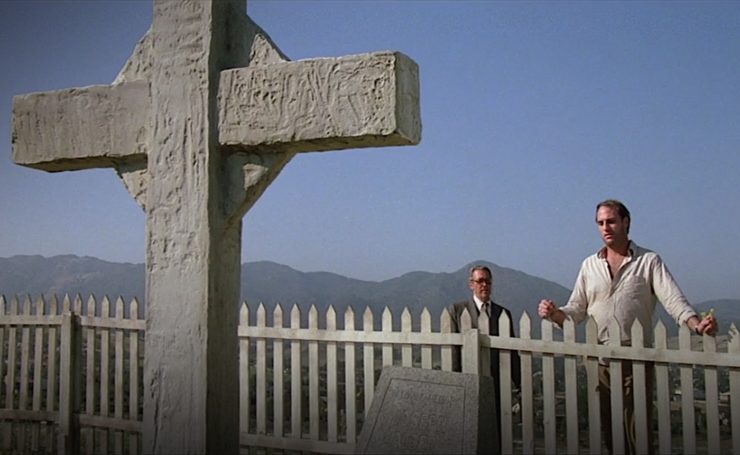
Steven rejects the offer (specifically he tells the boss to “go to hell”) but that doesn’t have any effect on the haunting—the dead are still under the house, unbeknownst to the Freelings. The Beast blocks Diane from the kids’ room, and the dead seem to be able to pop up strategically to keep her out of the house. After she battles her way back in, she’s only able to save her children from the Closet Vagina after she invokes God (I’m sidestepping the heck around this) but even then the dead seem intent on keeping them in the house.
Steven finally comes home, tries to help his family for a second, but stops in the middle of rescuing them to scream this at his boss:
You son of a bitch! You moved the cemetery, but you left the bodies, didn’t you? You son of a bitch, you left the bodies and you only moved the headstones! You only moved the headstones! Why? Why?
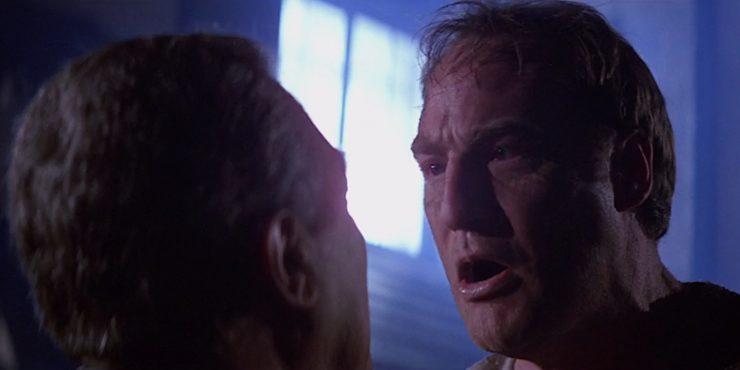
At which point E BUZZ comes galloping out, followed by the family, and leaps into their car’s driver’s seat. E Buzz, a very good boi, knows it’s time to get the fuck out of Dodge, and isn’t about to get derailed by yelling at anybody when all energy should be directed into escaping.
I’m left to assume the dog saved the family.
So OK, cool, but I have a few follow-ups:
What the hell are Tangina’s credentials? And why did she think the house was clean when Steven had clearly botched the rescue effort? Or was she just lying for the camera?
Don’t humans only get buried about 6 feet underground, and wouldn’t the construction crews have had to dig farther down for stuff like sewage pipes? Hell, even what we see of the half-finished pool—that hole is much deeper than six feet. So why wasn’t the crew hitting coffins left and right?
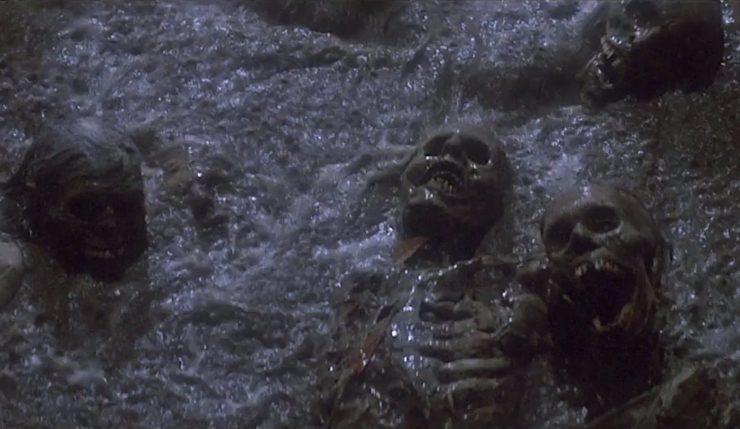
WHERE WERE ALL THESE DEAD PEOPLE FOR ALL THESE YEARS BEFORE CUESTA VERDE WAS BUILT??? Were they just, hanging around the cemetery, refusing to go into the light like proto-George Saunders characters, until finally the construction gave them something to do? We see skeletons, jewelry, and ghosts themselves that imply that some of the people have been dead for over 60 years by the time the movie starts. Have some of these spirits just been hanging around with nothing to do for half a century? Like, hoping someone would build them a house to haunt? Are they tied to their bodies? Why do they care if houses get built on top of them? The Freelings have lived in the house for five years—why are they only starting to haunt now?
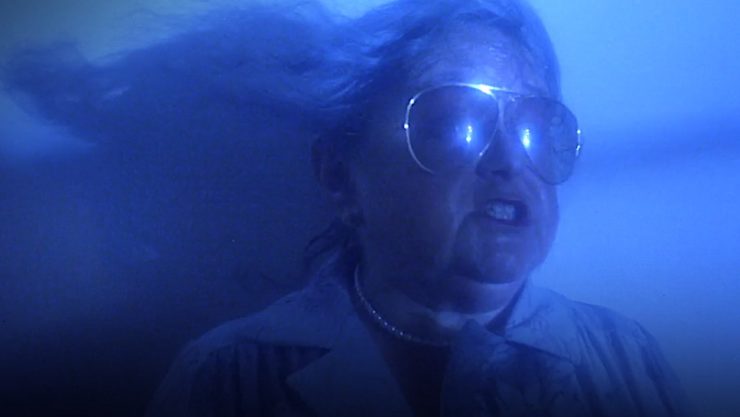
And finally what the hell is The Beast? Tangina says that it’s like nothing she’s ever encountered, but also seems to know how to fight it. She calls it The Beast, which to me implies a specific interpretation of the Christian devil, but if so, why doesn’t anyone think to get a priest on the horn? If we’re suddenly working within those parameters anyway. And if a priest won’t work, why does Diane suddenly succeed when she invokes God at the last minute? And why the heck didn’t she do that sooner? What are the rules here?
And yes, of course, I’m being extremely pedantic about this. If I’d lived in a house for five years, only to discover it was being haunted by the confused souls of people who were buried directly beneath the foundation, PLUS the Christian devil was (a) real and (b) trying to be bffs with my baby daughter, I’d probably panic. I only fight Evil the regular way, by tweeting and making donations to political candidates who agree with me—who knows what I’d do if I was suddenly in Diane’s shoes.
Anyway, as usually happens when I revisit my childhood favorites, my thoughts devolve into screaming in the end, and I’m left to contemplate all the ways these movies shaped my brain. Static-filled screens are lost to history now, but I still wish TV (and Twitter, and TikTok, and the internet in general) could just stop for a few hours a day to give us all a break from The Beast.
Leah Schnelbach is bound they’ll get over The Clown eventually, right? Come join them in the corpse-filled pool that is Twitter!










